Food and Beverage Services NC II
| Site: | fnbclass.gnomio.com |
| Course: | fnbclass.gnomio.com |
| Book: | Food and Beverage Services NC II |
| Printed by: | |
| Date: | Tuesday, 13 January 2026, 3:53 PM |
Description
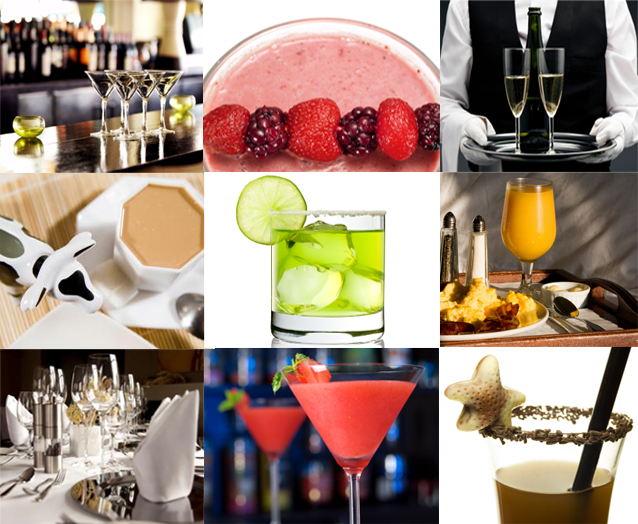
COURSE DESIGN
|
SUBJECT TITLE: |
FOOD AND BEVERAGE SERVICES NC II |
|
NOMINAL DURATION: |
160 HOURS |
|
SUBJECT DESCRIPTION: |
This course is designed to enhance the knowledge, skills and attitude in FOOD AND BEVERAGE SERVICES NC II in accordance with industry standards. It covers core competencies on cleaning bar areas, operating a bar, preparing and mixing of cocktails, providing link between kitchen and service areas, providing room service, providing food and beverage service, developing and updating of food and beverage knowledge and providing wine services. |
|
STUDENT ENTRY REQUIREMENTS: |
Student must possess the following qualifications, must be: · Able to communicate both oral and written. · Physically and mentally fit. · With good moral character. · Can perform basic mathematical and logical computations. · Analytical and logical thinking. |
COURSE STRUCTURE
|
Lesson 1: Introduction Food and Beverage Services Nominal Hours: 5 |
||
|
L.O. 1.1 |
Definition and Evolution of Food and Beverage Services |
|
|
L.O. 1.2 |
Types and Sectors of Food Service Industry |
|
|
L.O. 1.3 |
Food Service Method |
|
|
L.O. 1.4 |
Restaurant Service |
|
|
L.O. 1.5 |
Restaurant Lay-out |
|
|
Lesson 2: Organization and Responsibilities of Food and Beverage Operation Nominal Hours: 5 |
||
|
L.O. 2.1 |
Organizational Chart of Food and Beverage Industry |
|
|
L.O. 2.2 |
Associated Departments of Hotel Food Service |
|
|
L.O. 2.3 |
Professional Ethics for Good Food Service Personnel |
|
|
Lesson 3: Restaurant Equipment, Supplies and Table Appointments Nominal Hours: 10
|
||
|
L.O. 3.1 |
Service Equipment and Supplies in Restaurant Service |
|
|
L.O. 3.2 |
Table Appointments |
|
|
L.O. 3.3 |
Sanitation and Safety standards in handling food service equipment |
|
|
Lesson 4: Menu Nominal Hours: 5 Learning Objective: |
||
|
L.O. 4.1 |
Definition of Menu |
|
|
L.O. 4.2 |
Structure of the Menu |
|
|
L.O. 4.3 |
Basic categories of menu |
|
|
L.O. 4.4 |
Menu Planning |
|
|
L.O. 4.5 |
Menu Format |
|
|
Lesson 5: Art of Napery Nominal Hours: 15 |
||
|
L.O. 5.1 |
Basic Napkin Folds |
|
|
L.O. 5.2 |
Flat Napkin Folds |
|
|
L.O. 5.3 |
Standing Napkin Folds |
|
|
L.O. 5.4 |
Object/Dependent Napkin Folds |
|
|
Lesson 6: Table Skirting Nominal Hours: 15 |
||
|
L.O. 6.1 |
Styles of Table Skirting |
|
|
Lesson 7: Tray and plate handling technique Nominal Hours: 10 |
||
|
L.O. 7.1 |
Plate Carrying |
|
|
L.O. 7.2 |
Tray Carrying |
|
|
L.O. 7.3 |
Unloading Tray |
|
|
Lesson 8: Table lay-out and setup Nominal Hours: 15 |
||
|
L.O. 8.1 |
Standards of Table Setup |
|
|
L.O. 8.2 |
Set-up Procedures |
|
|
L.O. 8.3 |
Types pf Table Set-up |
|
|
Lesson 9: Pre-meal Service Nominal Hours: 15 |
||
|
L.O. 9.1 |
Mise-en-place |
|
|
L.O. 9.2 |
Errands for Food Service Preparation |
|
|
L.O. 9.3 |
Restaurant reservation |
|
|
Lesson 10: Sequence of Table Service Nominal Hours: 45 |
||
|
L.O. 10.1 |
Meet and greet guest |
|
|
L.O. 10.2 |
Escorting and seating customer |
|
|
L.O. 10.3 |
Offering pre-meal services |
|
|
L.O. 10.4 |
Presenting menus and drink list |
|
|
L.O. 10.5 |
Take food and beverage orders |
|
|
L.O. 10.6 |
Transfer orders to kitchen for service |
|
|
L.O. 10.7 |
Adjust settings and covers |
|
|
L.O. 10.8 |
Serve foods |
|
|
L.O. 10.9 |
Serve drinks |
|
|
L.O. 10.10 |
Present accounts to guest |
|
|
Lesson 11: Room Service Nominal Hours: 20 |
||
|
L.O. 11.1 |
Definition of room service |
|
|
L.O. 11.2 |
Kinds of room service |
|
|
L.O. 11.3 |
Take guest room service order |
|
|
L.O. 11.4 |
Set-up trays/trolley for room service |
|
|
L.O. 11.5 |
Delver room service order |
|
|
L.O. 11.6 |
Present room service |
|
|
L.O. 11.7 |
Clear room service |
|
1. Lesson 1: Introduction of Food and Beverage Service
|
1.1 Food and Beverage Service
- It is the climax of the relationship between a customer and a caterer during a meal experience.
- The actual contact with the customer is made at this stage of the food and beverage operation.
- The food and beverage department has three main operation areas, they are:
1. Food Production (Kitchen/Bakery)
2. Bar (Beverage)
3. Restaurant (Service)
Evolution of Food Service Industry
- The first encounters in the food and beverage service were recorded in the holy book. The stories of Abraham when he entertained angels in Mamre (Genesis 18:1-8) and Lot in Sodom when he met the same angels (Genesis 19:1-3).
- During the early times, medieval period, renaissance period and industrialized period, people always seek travel and accommodation. In every place people go, they dine and drink to harmonize with the society and environment.
- In the Philippines, the status quo of Food and Beverage Service started in three categories; the ‘Barrio Fiesta’, the ‘Town Fiesta’ and the ‘Provincial Events’.
- In the present day, Food Service Industry is divided in 2 main categories: Commercial Food Service Industry and Institutional Food Service Industry.
1.2 Types of Food Service Industry:
1. Commercial Food Service Industry
- It is a group of different food service establishments and is usually located in commercial or public areas especially in places where people are concentrated.
2. Institutionalized Food Service Industry
- It is made up of institutions or different institutions owning or operating food service establishment/s within their institutional boundaries in schools and hospitals.
3. Industrial Food Service Industry
- It is found in industrial areas or industrial parks where groups of different industrial manufacturing plants are concentrated. It caters to workers of different categories within its industrial boundaries.
Sectors of the food and beverage service industry
1. Hotels
- Provision of food and drink together with accommodation
2. Restaurants
- Provision of food and drink generally at medium to high price with medium to high levels of service
3. Catering
- Provision of food and drink generally at low to medium price with limited levels of service
4. Fast food
- Provision of food and drink in highly specialized environment characterized by high investment, high labor costs and vast customer throughput.
5. Take-away
- Provision of food and drinks quickly
6. Functions (banqueting/conferences/convention/exhibitions)
- Provision of food and drink on large-scale, usually pre-booked
7. Motorway service stations
- Provision of food together with retail and petrol services for motorway travelers.
8. Leisure attraction
- Provision of food and drink for people engaged in another leisure pursuit
9. Welfare (hospital/schools/colleges/universities/prisons/forces)
- Provision of food and drink to people through social need, primarily determined by an authority, social conscience
10. Industrial catering (in-house catering)
- Provision of food and drink to people at work
11. Transport
- Provision of food and drink to people on the move
1.3 FOOD AND BEVERAGE SERVICE METHODS
- The service of food and beverages may be carried out in many ways depending on a number of factors:
a. The type of establishment
b. The type of customer to be served
c. The time available for the meal
d. The turnover of custom expected
e. The type of menu presented
f. The cost of meal served
g. The site of the establishment
- There are 5 types of basic food and beverage method:
a. Table service- this is assisted by a waiter where the customer sits on his/her table and his/her food and beverage orders are served
b. Assisted service- a combination of waiter service and self-service where the food and beverage orders can be served by a waiter and at some point there are food and beverage items which are collected by the customer from a smorgasbord (open table with food and beverage items).
c. Self-service- the serving of oneself (as in a restaurant or gas station) with goods or services to be paid for at a cashier's desk or by using a coin-operated mechanism or a credit or debit card.
d. Single-point service- In this type of service, the guest orders, pays for his order and gets served all at a single point. There may be may not be any dining area or seats.
e. Specialized service- It is called special service because it provides food and beverage at the places which are not meant for food & beverage service.
1.4 Restaurant Service
Restaurant
- It is a food outlet that serves food and beverages to dine-in customers as differentiated from those being served in take-out counters or vending machines.
- It is a commercial establishment committed to the sale of food and beverage.
- It was derived from the Latin word, ‘resturare’ meaning ‘to restore’. It started when a soup vendor offered the King of France where the king was delighted to the soup he consumed. Through public commotion, the soup was merchandized as “le restaurant divin” (the divine restorative).
- A restaurant concept begins with an overview of marketing mix and market orientation. The main factors to be considered are:
a. The site is top priority as it determines the degree of contact or exposure to market
b. The size of the food and beverage operation determines the desired impact on the market
c. The menu is a fundamental aspect of the early decision-making process aimed to satisfying customer expectations.
d. Pricing policies determine the average spend and affect the sales volume
e. Service, in conjunction with the type of restaurant, menus, customers and seating arrangement
f. Opening hours, days according to marketing strategies and customer requirements
g. Décor and music, for pleasant environment which contributes to customer satisfaction
h. Standards and quality, it is according to customer requirements
i. Advertising and merchandising, to appeal to the market segments
j. Meal functions
- The type of service and the service procedures among restaurants vary depending on their classification, the type of food and services, the volume of orders and the composition of their prospective customers.
- Dine-in restaurants come in various types like:
1. Coffee shop - A concept borrowed from the United States, distinguished by its quick service. Food is pre- plated in the kitchen. The chefs prepare complete and balanced meal arranged in a plate. Coffee shop menus are quite light and simple.
2. Fine dining restaurants - it is usually designed for the elite market and they serve special dishes of superior quality, often with elegance of wine service and sometimes table side preparation and gueridon service.
3. Specialty restaurants - In such restaurants, the entire atmosphere and décor is geared to a particular theme normally related to regional cuisine. Specialty restaurants have gone further in giving the public ethnic foods within a region. The global world is allowing investors to bring cuisines to an ever adventurous and knowledgeable guest profile building restaurants to around the cuisine.
4. Grill room or Rotisserie - This is a restaurant that specializes itself in grills of different meats, fish and poultry. The distinguishing feature of this type of restaurant is a glass partition that separates the kitchen from the dining area so that the guest can see the grill preparation of her choice.
5. Discotheque - It is a restaurant which is principally meant for dancing to recorded music. The music is driven by a qualified and expert DJ who creates or responds to the moods of the guests. Special lighting and a dance floor are essential to the discotheque. A feature of the discotheque is a bar which also offers light meals and finger snacks.
6. Fast Food Restaurant - Fast food restaurants have practically taken over the modern dining experience. Fast food restaurants give ready-to-serve foods at reasonable rates. The guest pays cash and carries the foods instantly.
7. Cafeteria - meant for people with low meal budget. It serves value meals that are usually displayed in fast food counter.
8. Bars - Bars are where liquors are sold and consumed. In some parts of Europe they called it INNS; while in U.K they are called PUBS and TAVERNS. Bars have to be licensed to serve liquor as they have to follow strict laws and rules like closing time, serving underage persons, observing dry days, etc.
1.5 The Restaurant Layout
The restaurant layout must be designed to insure convenience of service to both service staffs and customers. The layout usually consists of:
1. Dining Area
For large restaurants with seating capacity of more than 100, and the orders come in big volume, it will be advisable to divide the dining area into stations with each station installed with 7-15 tables and about 30-50 seats. Each table must be given specific number for easy identification.
When a big dining area is split into smaller sub-areas or station, the span of control of a station head is smaller making supervision and monitoring or service more manageable and easier to control.
Each station (sub-area) is manned by a station head (or captain waiter), assisted by assigned waiters or food attendants. A busboy is assigned to each station and he acts as runner to the kitchen so that waiters can concentrate on order taking service, without having to leave their assigned station. For a more efficient delivery of service, waiters must be given specific table assignments.
2. Bar Counter
Restaurant serving drinks are advised to set up a bar counter where drink orders are placed and prepared. The bar area shall be equipped with a counter where various wines and drinks are displayed. The bar is manned by a bartender (if there are mixed drinks available) or a bar waiter who is in charge of drink preparation and dispatching. If there is a large volume of drink orders, a barboy may also be assigned to assist the bartender.
3. Food Display Counter
Restaurants serving buffet or fast foods or counter items usually set up a specific place for food display. This counter is manned by food dispatchers who must be in complete uniform, including hair net/cap, apron, gloves.
4. Dispatching Counter
The food from the kitchen must be dispatched through a window counter so that waiters need not to go to the kitchen to pick up and assemble orders. A food dispatcher is assigned to handle the dispatching of orders.
5. Cashier’s Counter
This is the area where the cashier is seated to attend to bill settlement. It must be equipped with a cash register or the Point of Sales System (POS), bill forms and receipts and other paraphernalia for cashiering.
6. Dishwashing Counter
The dishwashing area is placed inside the kitchen. However, there must be a window counter where soiled dishes will be placed by waiters, without having to enter the kitchen. Washed, cleaned wares will also be picked from this counter,
7. Service Station or Side Stand
This area is the place where preparations for service are undertaken. The station is equipped with sideboard or cabinet with drawers for placing the par stock of supplies, cutleries, condiments and service equipment to be used for set up and service.
8. Food Preparation Area (Kitchen)
The food preparation area must be located at the back or adjacent to the dining area so that the dispatching orders will be faster and more efficient.
Sample Restaurant Lay-out Plan

Restaurant brigade
- The manning requirements for each restaurant or any food outlet depend on the type of service and the volume of orders
- The required number of waiters or servers is usually calculated based on the productivity standard (number of covers or guest that a waiter can serve within a meal period). The standard varies for each type of service and the capacity of the dining personnel.
- Below-mentioned is the typical productivity ration used by large and medium-sized food establishment:
· 1 waiter/attendant for every 15 customers (American or Plate Service)
· 1 waiter for every table for 10-12 customers (Russian Service)
· 1 waiter for every 5 customers (French Service with side-table preparation
· 1 waiter for every 20-25 customers (Buffet Service)
· 1 waiter for every 20-25 customers or 4-5 tables (Family or Lauriat Service)
2. Lesson 2: Organization and Responsibilities of Food and Beverage Operation
2.1 THE FOOD AND BEVERAGE ORGANIZATIONAL CHART FOOD AND BEVERAGE DIRECTOR/MANAGER • One who is in charge of planning, organizing, leading, and controlling the food and beverage division in achieving its common goals especially in the delivery of the required standards of the service. The F and B director or manager oversees the outlet or restaurant manager, the room service manager, the bar manager, and the banquet/catering manager. RESTAURANT MANAGER/OUTLET MANAGER • He is in-charge of overseeing his assigned outlet and is empowered to lead his team to achieve the objectives of the dine service. Same as the director, he is the one planning, organizing, leading, and controlling but only within his boundaries of job description as an outlet manager. SENIOR CAPTAIN/ RESTAURANT SUPERVISOR • Organize, supervise and train all service personnel in the restaurant with a view to providing quick and personalized food and beverage service to guests. CAPTAIN WAITER or HEAD WAITER (MAITRE D’HOTEL) • To organize and supervise an assigned restaurant station with a view to providing fast and efficient food and beverage service WAITER or SERVER (CHEF DE RANG) • To provide quick and personalized food and beverage service to guests at allotted tables as per standards of service laid down and to guest satisfaction. RESTAURANT HOSTESS (RECEPTIONNISTE) • To receive and record table reservations requested for the restaurant. To extend warm and courteous welcome and hospitality to guests visiting the restaurant and allot them a table. BUSBOY or RUNNER or ASSISSTANT WAITER (COMMIS DE RANG) • To provide supportive help to stewards in mis-en-place, clearance of soiled dishes, table set-ups, replenishing guests water and drinks, and ultimate food and beverage service to guests. WINE BUTLER or WINE WAITER (SOMMELIER) • To present and serve wine and spirits to guests as per the standards of the establishments. CARVER (TRANCHEUR) • To present and serve prepared roasts to guests as per the standards of the establishment. ROOM SERVICE MANAGER (DIRECTEUR DU SERVICE EN CHAMBRE) • He has the same duties and responsibilities with the outlet manager and does managerial task of the room service manager. He also covers the room service department, to include the planning, organizing, leading, and controlling to ensure the quality of the service at hand. ROOM SERVICE CAPTAIN (CAPITAINE DU SERVICE EN CHAMBRE) • He takes charge that the delivery of the standard of service is practiced by the room service wait staff. The duties and responsibilities of the room service captain is similar with restaurant captain. They only differ with actual execution because room service captain deals with room service while the restaurant captain is in the outlet. ROOM SERVICE ORDER TAKER (PRENUER D’ORDRE DE SERVICE EN CHAMBRE) • He receives the call orders from the guests’ rooms and conveys this to the personnel assigned to deliver the prescribed standard of the room service. In the presence of the room service captain, the message is properly transmitted through channels to avoid complaints or to take actions immediately when necessary. ROOM SERVICE WAIT STAFF (SERVUER DE SERVICE EN CHAMBRE) • The one who is responsible to deliver the food and beverage orders of the guest in their room. BAR MANAGER (GERANT DE BAR) • He is in charge of managing the bar; has the same obligations with the other managers that focus mainly on the assigned outlet. They do planning, organizing, leading, and controlling and conveying information to the team and delivering the prescribed standards in serving beverage. BAR CAPTAIN (CAPITIANE DE BAR) • This one is in charge in supervisory tasks keeping everything intact and making sure that his subordinates comply with the standard operating procedures. If there is a captain in the dining area who’s concerned is mainly food, bar captain’s focus are beverages. BARTENDER (BARMAN) • The bartender is the one who is in charge of mixing alcoholic and non-alcoholic beverages local or international. Bartenders do not only mix drinks, they also perform entertainment associated with their work areas like flair tending. BAR BOY/BAR BACK (BARRE ARRIERE) • If there is a runner in the dining area in the bar, we call him bar boy. He helps the bartender in doing the mise-en-place, clearing the glasses, preparing garnishes and other things where he could be of help within the bar station. BANQUET MANAGER (DIRECTEUR DE BANQUET) • Upon the orders from the F and B director, the banquet manger will now start the planning, organizing, leading and directing the team banquet to mise-en-place the function room or hall before the guests arrive in a given period of time. He then talks to his men delegating duties and responsibilities to give best results of the endeavor. BANQUET CAPTAIIN (CAPITAINE DE BANQUET) • The banquet captain is the supervisor of the team for he oversees his men and assures that they are well assigned in their field of expertise. BANQUET WAIT STAFF (SERVEUR DE BANQUET) • The banquet wait staffs are in charge of assisting the guest to their needs during the function within the limits of the menu and the services required. BANQUET RECEPTIONIST (RECEPTIONNISTE DE BANQUET) • The banquet receptionist is the one greeting and assisting guest to their table. A receptionist must possess a good and pleasing personality; a good conversationalist to make the guest feel at home upon approaching the hall or the function room 2.2 Associated Departments of Hotel Food Service Kitchen: a kitchen is a place where food is prepared Butchery: in this section, raw meats are cut from wholesale cuts and carcasses into smaller portions of given weight ready for cooking. This section also is responsible for curing meats like bacon, sausages and hams by having curing chambers. Garde Manger: is the section where cold dishes such as hors d’oeuvres, cold meat cuts, salads, galantines and pates are made. Hot Range: it is the main cooking range where hot foods are made. They have wide variety of equipment for ranges and cooking. Chef-de-cuisine is the head of the kitchen responsible for planning, organizing and controlling the kitchens operation. His main concern is to maintain the established food cost, which he achieves through strict food control. He drives the food safety programs and ensures that all staff is hygienic. Sous Chef: is the deputy who shares some of the Chef –de-cuisine’s responsibilities. He directs kitchen operation in his absence. Chef-de-parties: are supervisors responsible for a section in the kitchen. They translate the management’s policies and procedures into their sections. Specialist Chef-de-parties are those who developed skills in specific field of the kitchen. They are the: 1. Chef Tournant- a reliever chef or swing chef who can replace any of the regular chef-de-parties in their absence. Therefore this specialist has to have a wide variety of cooking skills. 2. Chef Saucier: is a specialist in sauces. 3. Chef Patissier: is specialized in confectionary items specially cakes and pastries. 4. Chef Rotisseur is skilled in roasts and grills and is assisted by the Grillardin and the Savourier. Grill cook and savories cook respectively. 5. Aboyeur- is the announcer of dishes for preparation of various sections, once orders come in from the restaurant. He is also known as the ‘barker’ who coordinates the restaurant orders with the kitchen. 6. Chef Garde Manger- responsible for the cold kitchen preparations. 7. Chef Bouchier is the expert in butchery and meat cuts. Another variation to the butcher is the Chef Charcutier who is expert on pork based items like sausages, ham, etc. 8. Chef Poissonier- specializes in fish preparations. 9. Chef Potager- responsible for the Soup section. 10. Chef Communar- responsible for the staff cafeteria meals. 11. Chef Entremetier- who prepares vegetable dishes. 12. Chef Volailler- the poultry man specialized in chicken items and game birds. 13. Breakfast Cooks- specialist of breakfast items including various preparation of eggs, pancakes, and breakfast meats. 14. Chef de Banquets- specialist in the preparation for quantity cooking for banquets. 15. Chef de Nuit (the night cook) specialist in their own way as he is multi-skilled to prepare food from any section of the kitchen. 16. Commis: are general cooks who make the food items. They may be given titles of Commis I, Commis II and Commis III based on their experience and skill level. 2.3 PROFESSIONAL ETHICS FOR GOOD SERVICE PERSONNEL “Customers judge a restaurant, bar or hotel not only by the quality of food and facilities, but also by the kind of people who serve them.” Service personnel reflect the image of the company. They must therefore carry themselves in a professional manner to make a good impression. Professionalism is quality that is projected in terms of: A. Physical Projection a. It is advisable to require employees to wear a uniform. But it must be properly pressed, no sagging hemline, not faded, etc. If not into uniform, they should refrain from wearing too casual attire like step-in, denim pants, t-shirt without collar, etc. b. Avoid too many jewelleries, dangling earrings, low neckline or too much make up. c. Always carry a pleasant smile and positive disposition so that others will feel more comfortable and at ease with you. d. Be careful of overtones- tone volume and body language. Avoid unpleasant non-verbal like sneering look, crossing arms, pointing finger, frowning face, deep sighs, biting lips, shaking head. Keep a low modulated tone and volume. e. Maintain poise and posture by direct eye contact, erect posture, refraining from unpleasant mannerisms like scratching head, etc. f. Strictly observe the following grooming standards: o HAIR - Clean, neatly combed; no dandruff - Ladies hair should be clipped on both sides or breaded (if it is long) - Length of men’s hair should not go beyond collar and the side hair must not cover the ears. - Bangs should be avoided - Refrain from using hair colours or hair dyes o UNIFORMS - Must be comfortably fit; no sagging hemline - Properly buttoned; sleeves should never be folded nor rolled - Clean and well pressed; free from stains nor wrinkles o FACE - Ladies should apply light make up. - Not oily - Free from pimples and blemishes o MOUTH - Free from bad breath. - No tooth decay o EARS - Clean and free from visible dirt inside and outside - Earrings are never appropriate for men; ladies should never wear dangling earrings o BODY - Free from body odor; apply deodorant daily - Daily shower is a must. o FINGERNAILS - Clean and free from dirt - Should be short and properly trimmed. o SHOES AND SOCKS - Should be clean and well-polished; heels in good condition - Change daily with fresh ones - Ladies should wear stockings but must be ensure it has no ‘run’ or damage. o PERFUMES - Using of perfume is not allowed much as the smell contaminates the food. B. Verbal Projection a. Speak with clarity or speak in audible b. Observe right speed, not too fast or too slow. c. When receiving messages, always seek to confirm or clarify anything that sounds unclear. d. Accept and respect the opinion and ideas of others. e. Make it a habit to use magic words. f. Avoid saying directly no or cannot be when turning down a request. g. Be sensitive to the feelings and self-esteem of others. h. Listen with interest and undivided attention. C. Work Behaviour and Habit A professional waiter/server must behave with gentleness and in strict observance to the rules of basic courtesy and work ethics. o Some habits to be avoided are - Smoking, coughing/sneezing - Scratching body parts - Tasting food in view of the customers. - Handling food with bare hands - Yawning - Using sign language - Shouting, giggling, loud conversation and horse playing - Leaning on walls, tables and chairs - Chewing gum - Suggesting or demanding for a tip - Counting tips in view of the customers - Airing grievances against the company to the customer - Too much familiarity with the customers - Singing/Whistling - Use of rude and insulting language. - Pointing at something or someone with a finger.3. Lesson 3: Restaurant Equipment, Supplies and Table Appointments
|
3.1 Service Equipment and Supplies in Restaurant Service
1. Gueridon Trolley
- Used for table side preparation. In French service, a chef prepares dishes in this trolley which is positioned beside the guest’s table.

2. Bussing Trolley
- Used to gather soiled dishes to be carried to the dishwashing area.
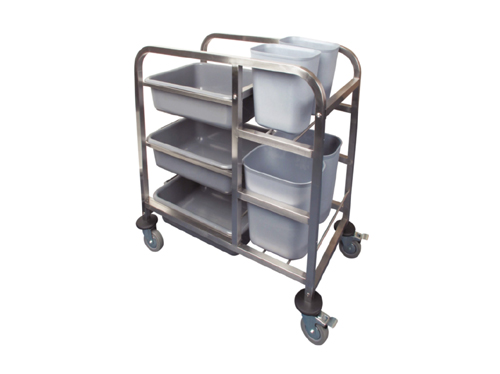
3. Folding side tray
- A portable folding tray where “ready to serve plated food” is assembled, then served at the guest’s table. It is placed right beside the guest table.
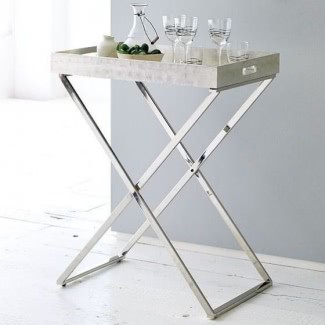
4. Glass Divider rack (Plastic or Wired)
- Used to store glasses. The divider in the rack is designed to prevent glass to glass contact which can cause breakage.
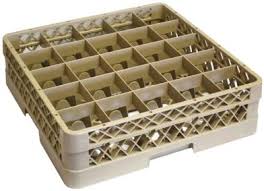
5. China rack
- Used for racking and storage of china wares.
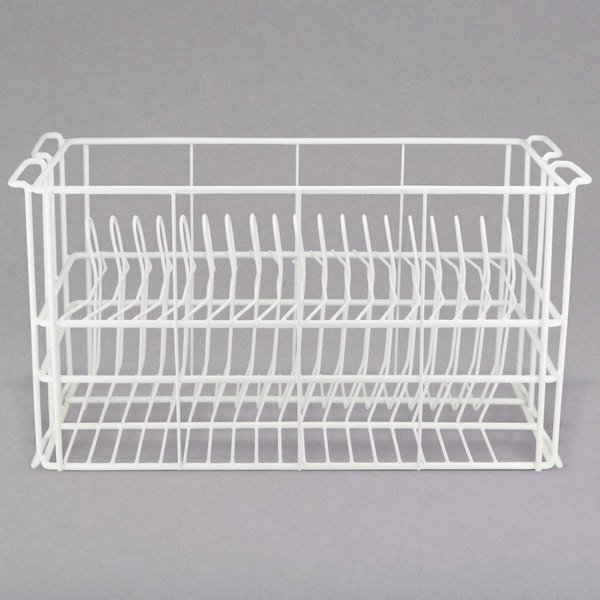
6. Cutlery rack
- Rack for cutleries. It can be thermal or laminate divider.
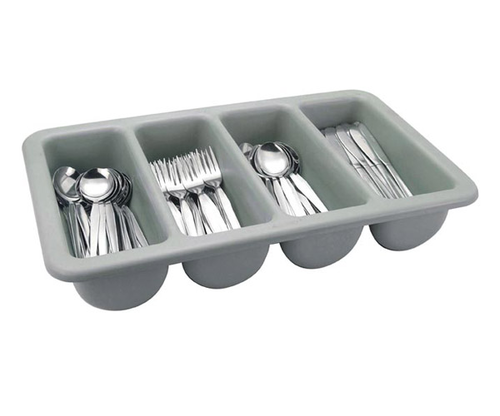
7. Service trays
- Used in assembling and serving food and drinks.
It include round, rectangular and oval tray.
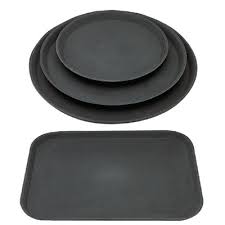
8. Menu stand and Table number
- Used to identify each table in the dining area

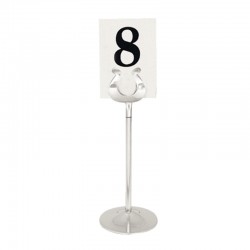
9. Change tray/Bill tray and Bill folder
- Used to place the payment, change or even tip from the customer’s total bill
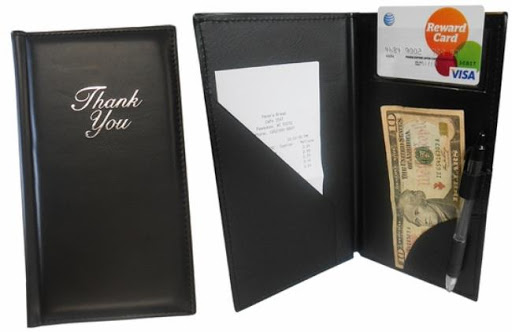
10. Flower vase (for centerpiece)
- Used to accentuate the tables in the dining area
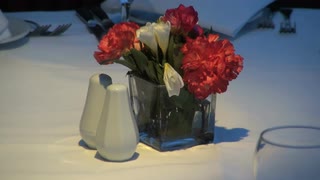
11. Salt/Pepper shaker (cruet set)
- Containers for condiments

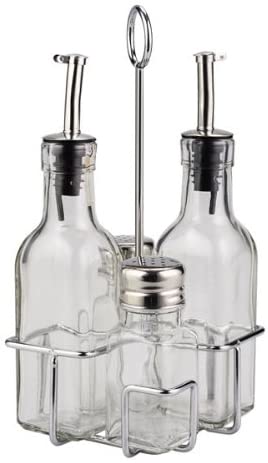
3.2 Table appointments
- It implements used for dining which consist of linen, silverware and/or flatware, dinnerware or chinaware, glassware and the centerpiece.
1. Chinaware/Dinnerware/Plate ware/Crockery
- Any item in the dining room that are soup plate, service plates, saucer, bread plate, dinner plate, etc.
- It is made up of different materials, this includes the following:
a. Ceramic- it includes earth materials such as sand and other minerals and is processed by cooking or baking.
b. Earthenware- it is produced in the UK in vast quantities and is the cheapest and least durable plate. Its main uses are in institutional catering where price rather than durability is main consideration.
c. Stoneware- this is a natural ceramic material traditionally made in the UK and fired at a very high temperature, about 120 degrees Celsius. It is non-porous and extremely durable with high thermal and shock resistance.
d. Porcelain- this is of completely different composition with semi-translucent body, normally blue/grey, and has a high resistance to chipping.
e. Melamine- it is a chemical name for plastic dinnerware.
Different types of dinnerware:
a. Show plate- it is also called as Place plate. It measures 12”-14”in diameter and is used as an underliner in formal dinner.
b. Dinner plate- it is used for main course. Usually, it measures 10”-11” in diameter.
c. Soup plate- it is used for both cold and hot soup. Usually, it measures 9” in diameter.
d. Fish plate- it is used for fish dishes. Usually, it measures 8.5” in diameter.
e. Salad plate- it is used for salads. Usually, it measures 8” in diameter.
f. Dessert plate- it is used for sweets. Usually, it measures 7” in diameter.
g. Bread plate- it is used for breads and buns. Usually, it measure 6” in diameter.
h. Saucer- it is used as an underliner for coffee cup. Usually, it measures 4” in diameter.
List of crockery items:
a. Cream container- contains creamer that serves a condiments for coffee or tea.
b. Sugar container- contains sugar that serves a condiments for coffee or tea
c. Milk jug- contains milk that serves a condiments for coffee or tea
d. Coffee pot- used to serve brewed coffee for customers
e. Tea pot- used to serve brewed tea for customers
f. Coffee cup and saucer- an appointment used for serving coffee
g. Demitasse cup and saucer- an appointment used for serving expresso or tea
h. Cereal bowl- an appointment used for English breakfast of which it includes cereal.
i. Monkey dish- an appointment used for dipping sauces
j. Bouillon cup and Consommé cup- an appointment used for thin or clear soup
k. Egg holder/Coupe- an appointment used to hold soft boiled eggs
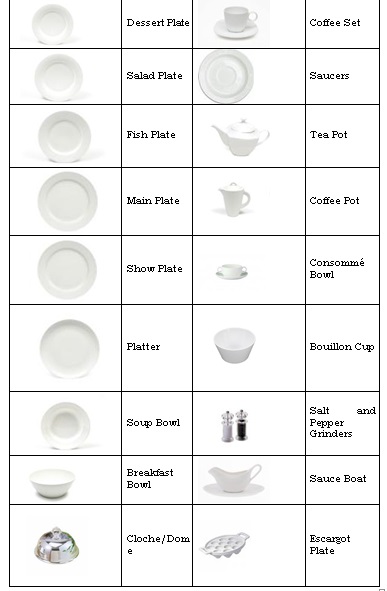
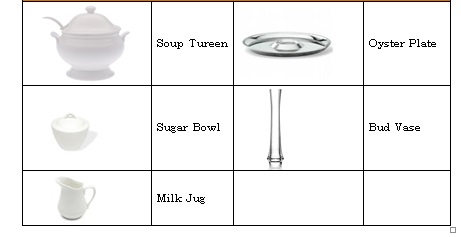
2. Tableware (Flatware/Cutlery/Hollow-ware)
- Flatware denotes all forms of spoon and fork
- Cutlery refers to knives and other cutting implements
- Hollow-ware consists of any item made from silver, apart from the two previous tableware
- It is made either in silver or in stainless steel.
Different tableware:
1. Forks
· Dinner fork- 4 prongs
· Fish fork (webbed fork)- 4 prongs
· Salad fork- 4 prongs
· Oyster fork- 3 prongs
· Cocktail fork- 3 prongs
· Dessert fork- 3 prongs
· Escargot fork- 2 prongs
Relish/Pickle fork- 2 prongs
2. Knives
· Dinner knife
· Steak knife (corrugated)
· Fish knife
· Salad knife
· Dessert knife
· Butter knife/butter spreader
· Cheese knife
3. Serving implements
· Ladle
· Cake server
· Serving spoon
· Serving fork
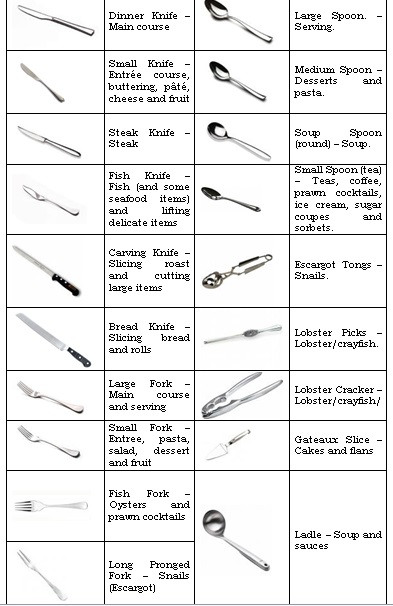
3. Glassware
- It is used for the different beverages served in the restaurant.
- There are different types of glassware, these include the following:

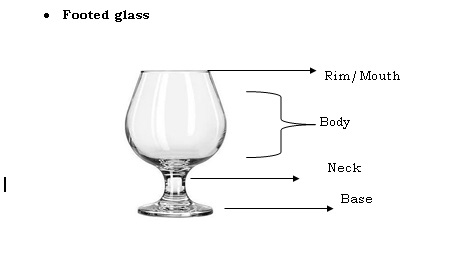

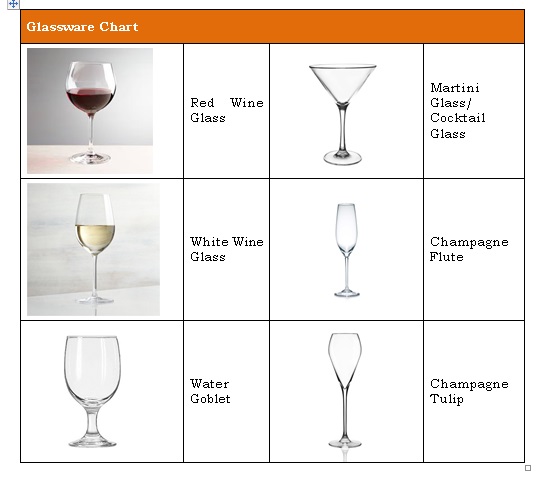
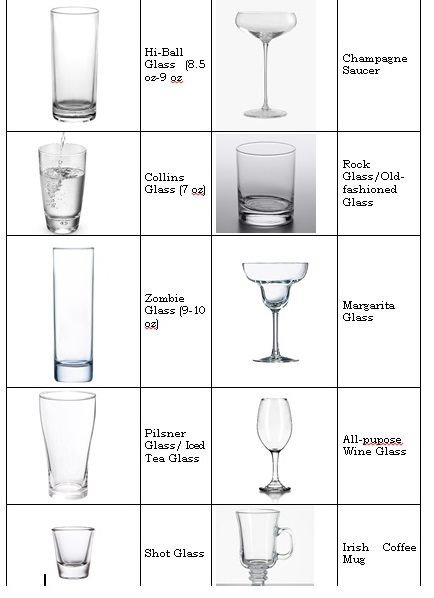
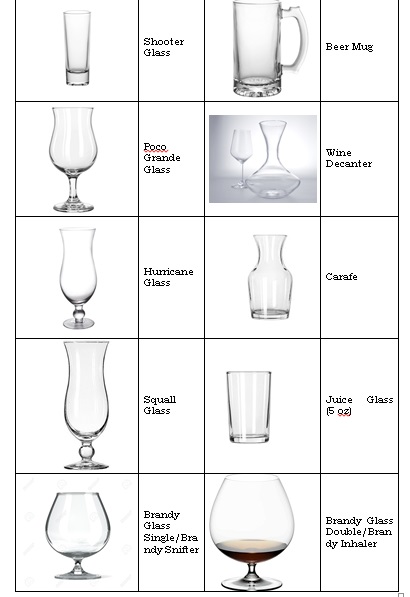
4. Linen
- It applies to any fabric or mat, used for a cloth cover in the dining table with the accompanying napkin.
- It should be durable and serviceable, attractive and suited to other appointments, reasonably priced and easily laundered.
- There are different linens used in a restaurant, these includes:
· Tablecloth- a material used to cover tables for the dining room
· Silence cloth- a material placed on the table under the table cloth used to avoid noise, to avoid breakages, to make the table fold beautifully
· Napkins- should always match or complement the table cloth. There are different sizes used according to its purpose.
· Place mats- it must be large enough to hold the entire place, setting should hold the silverware, napkin, china; edge should be at the edge of the table
· Table runners- pieces of cloth placed across the table to accommodate at least two setting
|
ITEMS |
LINEN SIZE
|
|
I. Toppers |
|
|
A. Round tables a. 72” in diameter b. 60” c. 54” d. 36” |
(diameter size) 120 inches 110 inches 96 inches 54 inches |
|
B. Rectangular tables a. 36” X 72” b. 18” X 72” Square Table 3’ Slip Cloth |
108” x 72” 108 “ x 36” 72” x 72” 36” x 36” |
|
C. Crescent tables a. 54” x 72” |
108” x 96” |
|
D. Half moon 36 inches |
2” x 54” |
|
II. Cloth Napkin/ Table Napkin · For dinner · For cocktail |
18” x 20” 4” x 8”
|
|
III. Place mat |
14” x 20”
|
|
IV. Skirting for tables 36” x 72” |
72” x 308” |
3.3 SANITATION AND SAFETY STANDARDS IN HANDLING SERVICE EQUIPMENT
A. Rules in Sanitation and Handling of Food and Beverage Service Equipment
1. Store food products immediately after they are received in their appropriate temperature.
2. Use proper personal hygiene by washing hands thoroughly for 20 seconds with soap and water before and after handling food.
3. Use only clean utensils such as ladles and tongs when handling food. Do not touch or handle with bare hands.
4. Dispose unserved or unsealed food items that are not consumed.
5. Transfer opened canned foods and juices in sealed glass or stainless container and label them (name, expiration date.
6. Don’t mix old batch of food with new batch. Use separate containers with cover and put labels.
7. Store ready to eat foods above raw foods in cooler, if necessary.
8. Follow FIFO (First In, First Out)
9. All service equipment must be wiped dry with clean wiping cloths.
10. Equipment should not be exposed to contamination. Keep them in close drawers or cabinets, not exposed to open air and dirt.
11. Use scooper for serving ice, serving spoon and fork for dishing out foods.
12. When setting up cutlery and glasses, carry them in trays or place them inside a cloth napkin
13. Never serve food and cutlery that have fallen on the floor.
14. Always wash and wipe dry food containers before using them.
15. Check service station for cleanliness and possible pest infestation. Keep station neat, clean and free of foul odour.
16. Hold fork by the handle, not the tines.
17. Hold glass at the base or stem of the glass, not inside or by the lid.
18. Hold cup by the handle, not at the rim.
19. Hold plate with thumbs under the plate.
B. Rules in Handling of Food and Beverage Service Equipment
1. Use appropriate trays during actual service and bussing.
2. Decoy System should be followed in stacking and storing equipment.
3. Use appropriate door for entry and exit. A separate door for entering and going out should be installed to prevent collisions, which cause accident.
4. Report potential hazards immediately, such as broken tiles. LPG gas with leaks, malfunctioning equipment, etc.
5. Follow manufacturer’s instructional procedures regarding the proper use of all appliances.
6. Place heavy items at the center of the tray to keep it balanced.
7. Let the tray rest on the shoulder with the palm of the hand supporting the tray underneath. Rest the elbow close to the hip when carrying a tray.
8. Make sure the bottom of the tray is clean.
9. Bend the knees not the back, when picking up tray and when putting it down.
C. Some Cause of Breakages.
1. Mechanical Impact
- Results from an object contact, stacking up glassware and hollowware into more than acceptable height; or stacking different sizes of china and plateware together which could cause breakages.
2. Thermal Shock
- The abrupt exposure of breakable equipment from cold to hot temperature or vice versa, resulting in cracks or breakage.
3. Improper Handling and Misuse of Equipment
- Using equipment for a purpose other than what is intended for.
4. Improper Racking and Stacking
- Stacking glasses and stacking chinaware that are different sizes and shapes.
5. Lack of presence of mind
- Results in an accident wherein personnel are inattentive.
6. Environmental Factors
- The presence of safety hazards that can cause accident.